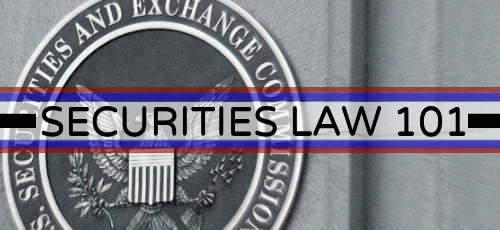SECURITIES LAW AND REGULATION
By – Samriddha, Madhusudan Law University, LL.M
Introduction
Securities in the banking sector are the safety or guarantee that may be personal, verbal, or in the form of any property. When a creditor lends a loan, it is essential for them to secure the same through different kinds of securities. Thereby, security becomes the right of a creditor in the form of property or anything that can convert the same into cash in case the debtor fails to repay the amount advanced with the interest. Security in the banking sector can be defined as a financial instrument or asset that can be easily traded in the open market. For instance, stocks, bonds, options, shares, contracts, etc. are the examples of securities. Securities have the ability to be exchanged or traded as financial instruments in order to raise capital in both private as well as public markets. The different types of security laws are as follows:
The security market is a marketplace for the purchase and sale of securities such as stocks, bonds, and other financial instruments. The security market must be regulated to maintain its orderly operation and to protect investors’ interests. Securities law and regulation in India are intended to protect investors’ interests and promoting the orderly and fair operation of the securities market.
The Following are some of The Reasons Why the Security Market should be Regulated:
- Investor Protection: Regulating the security market protects investors’ interests by ensuring that securities are issued and exchanged in a fair, transparent, and efficient manner.
- Market Integrity: Regulating the security market contributes to its integrity by avoiding market manipulation, insider trading, and other illicit acts that can weaken investor trust and destabilise the market.
- Fostering Competition: Regulating the security market promotes competition by ensuring that all market participants have equal access to information and resources, as well as by prohibiting dominant actors from engaging in anti-competitive behaviour.
- Investment Encouragement: A well-regulated security market stimulates investment by instilling confidence in the market and the securities traded on it.
- Promoting Capital creation: Regulating the security market encourages capital creation by giving enterprises and other issuers access to capital and allowing investors to invest in a diverse variety of financial instruments.
The following are the important rules and regulations that govern the Indian securities market:
- Securities and Exchange Board of India (SEBI) Act, 1992:
The SEBI Act is the principal piece of legislation that oversees India’s securities market. It establishes SEBI as the primary regulator of the securities market and gives it the authority to enact rules and regulations for investor protection and the orderly operation of the securities market. The Securities and Exchange Board of India (SEBI) introduced the consent mechanism in 2007 as an alternative and efficient dispute resolution process for securities law violations. This was later codified in the SEBI (Settlement of Administrative and Civil Proceedings) Regulations, 2014, in response to the Securities Laws (Amendment) Act, 2014, which expressly empowered SEBI to settle matters in order to remove any doubt about the validity of the settlement process. In a nutshell, settlement is an alternative mechanism that provides a framework for bringing regulatory violations to a close by the payment of a settlement sum and compliance with other directions. The 2018 Regulations made the regime more principle-based, allowing SEBI more leeway in resolving certain major crimes, save in cases with market-wide impact, inflicting loss to a significant group of investors, or harming market integrity.
- Securities Contracts (Regulation) Act (SCRA), 1956:
The SCRA is a central law that governs securities trading in India. It regulates securities contracts, including the ban of insider trading, and it regulates stock exchanges and brokers. Some of the important judgments under the Securities Contracts (Regulations) Act, 1956 are:
- MCX Stock Exchange Limited Versus Securities & Exchange Board of India, 2012 (Bombay High Court): The Bombay High Court in this case, clarified the validity of option contracts under the Securities Contracts (Regulation) Act, 1956 and stated that option contracts are different from forward contracts.
- The Madras Stock Exchange Limited Versus S.S.R. Rajakumar, 2003 (Madras High Court): The Madras High Court, in this case, reversed the wrongful expulsion of the respondent who was made liable to pay the applicant a sum of Rs. 30 lakhs by a subordinate court.
- Parikh Versus Union of India, 2014 (Gujarat High Court); the Petitioner had challenged the legality and validity of certain circulars and the Securities Contracts (Regulation) (Stock Exchange and Clearing Corporations) Regulations, 2012 issued by the SEBI stating that they are inconsistent with the provisions of the Indian Constitution. The Gujarat High Court dismissed the petition of the Petitioner in this case and upheld the validity of all the challenged circulars and regulations.
- Companies Act, 2013:
Regulates the formation, operation, and management of corporations in India. It regulates company securities offerings, including the necessity for corporations to disclose material information to investors and file annual reports with the MCA. The Act impacted the registration and requirements of many investment companies and made financial regulation tighter, giving the SEC more power to oversee the financial markets. It created rules that protected investors and required investment companies to disclose certain information. Financial regulation became more robust under the Act.
- Depositories Act,1996:
The Depositories Act establishes and regulates depository participants, who operate as intermediaries between investors and the depository, as well as the depository system in India. The depository system is intended to provide a safe and efficient way for Indians to retain and trade assets. The Act makes offences, such as, unauthorized acceptance of deposits by any entity, firm or company a cognizable offence, that is entities that are indulging in unauthorized deposit acceptance or unlawful financial activities can be immediately imprisoned and prosecuted. Protection of Interest of Depositors in Financial Establishments Act to help in nailing unincorporated entities and companies from illegally accepting deposits.
- Prevention of Money Laundering Act, 2002:
The Prevention of Money Laundering Act (PMLA) is a central law in India that regulates money laundering and terrorism financing. The PMLA compels companies involved in securities transactions, such as brokers and depository participants, to follow anti-money laundering standards and report suspicious transactions to authorities. Money Laundering refers to converting illegal earned money into legitimate money. Money laundering is commonly defined as happening in three steps: the first step involves introducing cash into the financial system by some means (placement); the second involves carrying out complex financial transactions to camouflage the illegal source (layering); and the final step entails acquiring wealth generated from the transactions of the illicit funds (integration).
- SARFAESI Act, 2002:
SARFAESI Act or Securitisation and Reconstruction of Financial Assets and Enforcement of Security Interest Act, 2002 was formulated with an intent to empower banks to recover Non-Performing Assets (NPAs) without the intervention of a court. SARFAESI Act 2002 is a milestone in the recovery of NPAs. It helped a lot in recovering the defaulting loans and reducing the levels of non-performing assets (NPAs) in banks and other financial institutions. Narasimham Committee and Andhyarujina Committee were constituted by the Central Government for the purpose of examining the overall reforms in the banking sector and determining the changes in the prevailing legal system for banks. SARFAESI Act is a law that allows Indian banks and financial institutions to sell or auction the assets/properties of credit defaulters without any intervention from the courts.
Role of SARFAESI Act, 2002
Conclusion
In addition to all these laws, SEBI has released a variety of regulations and guidelines that apply to the Indian securities market, such as rules on insider trading, market manipulation, and company disclosure of material information. The main regulatory bodies that oversee the securities market in India are SEBI, the MCA, and the Ministry of Finance. SEBI is responsible for regulating the securities market, including the issuance of securities by companies and the trading of securities on stock exchanges. The MCA is responsible for the incorporation and regulation of companies in India, including the issuance of securities by companies. The Ministry of Finance is responsible for the overall regulation of the financial sector in India, including the securities market.
Overall, regulating the security market is important for maintaining the integrity of the market, protecting the interests of investors, promoting capital formation, and fostering competition. The specific regulations and laws that apply to the security market vary from country to country, but the underlying objectives of regulation are typically similar. To be an effective player in the securities market in India, it is important to have a good understanding of these laws and regulations and to comply with them.
References
- “Securities Law Series: SEBI and The Basic Structure of Securities Enforcement in India,” Bar and Bench – Indian Legal news, 2023available at: https://www.barandbench.com/columns/sebi-and-the-basic-structure-of-securities-enforcement-in-india (last visited May 5, 2023).
- “Justice Anil R. Dave Committee Report on Settlement Mechanism,”
- Ana Carvajal and Jennifer Elliott, “Strengths and Weaknesses in Securities Market Regulation: A Global Analysis.”
- “Securities Law Series: SEBI and The Basic Structure of Securities Enforcement in India,” Bar and Bench – Indian Legal news, 2023available at: https://www.barandbench.com/columns/sebi-and-the-basic-structure-of-securities-enforcement-in-india (last visited May 5, 2023).
- Gazal Rawal Gandhi Rutu, “Amendments to SEBI Settlement Regime – A Snapshot” India Corporate Law, 2022available at: https://corporate.cyrilamarchandblogs.com/2022/01/amendments-to-sebi-settlement-regime-a-snapshot/ (last visited May 1, 2023).
- “SECURITIES CONTRACTS (REGULATION) ACT, 1956,.”
- Manohar Samal Manohar Samal is a budding litigator et al., “Securities Contracts (Regulations) Act, 1956,” 2020available at: https://www.asianlaws.org/blog/a-guide-to-the-securities-contracts-regulation-act-1956/ (last visited May 5, 2023).
- “Investment Company Act of 1940 Definition,” Investopediaavailable at: https://www.investopedia.com/terms/i/investmentcompanyact.asp (last visited May 5, 2023).
- “PROTECTION OF INTERESTS OF DEPOSITORS (IN FINANCIAL ESTABLISHMENTS) ACT, 2018,.”
- WeHUBS INNOVATIONS, “Protection of Interest of Depositors in Financial Establishments Act” Indian Economyavailable at: https://lms.indianeconomy.net/glossary/protection-of-interest-of-depositors-in-financial-establishments-act/ (last visited May 5, 2023).
- “Prevention of Money Laundering Act (PMLA), 2002 – iPleaders,”available at: https://blog.ipleaders.in/prevention-of-money-laundering-act-pmla-2002/ (last visited May 5, 2023).
- Taxmann, “Guide to Prevention of Money Laundering Act | PMLA” Taxmann Blog, 2022available at: https://www.taxmann.com/post/blog/guide-to-prevention-of-money-laundering-act-pmla/ (last visited May 5, 2023).
- “The Securitisation and Reconstruction of Financial Assets and Enforcement of Security Interest Act, 2002,”available at: https://indiankanoon.org/doc/52229129/ (last visited May 5, 2023).
- Staff Desk, “SARFAESI Act 2002” Vakilsearch | Blog, 2022available at: https://vakilsearch.com/blog/sarfaesi-act-2002/ (last visited May 5, 2023).
- “Narasimham Committee – Wikipedia,”available at: https://en.wikipedia.org/wiki/Narasimham_Committee (last visited May 5, 2023).
- “Securities Market and the Laws Regulating it in India,”available at: https://legalserviceindia.com/legal/article-10243-securities-market-and-the-laws-regulating-it-in-india.html (last visited May 1, 2023).













